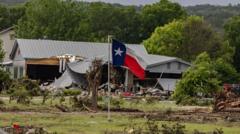After the recent tragic floods in Texas, concerns have arisen over how federal budget cuts may have impacted the National Weather Service's ability to predict such disasters. While staffing levels were affected by previous cuts, officials maintain that forecasts during the event met standards, although questions linger about local communication capacity.
Did Budget Cuts Impact Weather Forecasting During Texas Floods?

Did Budget Cuts Impact Weather Forecasting During Texas Floods?
The link between federal budget cuts and the recent Texas floods is under scrutiny, sparking debate among experts and officials about forecasting capabilities.
In the wake of devastating floods in Texas, some Democrats have raised alarms about the potential link between the Trump administration's federal workforce cuts and the tragedy. Senator Chris Murphy emphasized the importance of accurate forecasting to prevent disasters, implying that reduced staffing at the National Weather Service (NWS) may have hindered timely warnings. However, White House Press Secretary Karoline Leavitt firmly claimed that current staffing levels at NWS were sufficient, calling allegations to the contrary “completely false.”
An analysis by BBC Verify indicates that while a proposed 25% cut to the National Oceanic and Atmospheric Administration (NOAA) budget, which oversees the NWS, is set for the 2026 financial year, these adjustments did not directly contribute to the flooding. Still, the Trump administration's previous initiatives had already resulted in notable staff reductions, leading to a loss of about 600 positions out of 4,200 at the NWS due to voluntary buyouts, early retirements, and firings.
Data previously reported highlighted that around half of NWS offices carried a staffing vacancy rate of 20%, double what it was ten years ago. Nonetheless, experts expressed confidence in the forecasting and warning systems that were activated during the recent flooding, noting that extreme local rainfall events pose inherent challenges to predictions. Forecasts issued were described as normal and adequate for the dysfunction that occurred, according to climate professionals like Avantika Gori at Rice University.
Despite the general confidence in forecast quality, some experts pointed to staffing shortages affecting communication between local NWS offices and emergency services. Climate scientist Daniel Swain from UCLA mentioned the potential for improved coordination if certain roles had not been eliminated during the staffing cuts, specifically highlighting vacancies within local offices in Texas that were critical during the flooding events.
Conversely, NWS representatives indicated that staff levels had been bolstered to prepare for the flooding, establishing a heightened presence in areas like Austin/San Antonio and San Angelo in the days before the crisis. Afforded extra forecasters should an emergency arise, it was reported that staffing could be as high as five forecasters on duty compared to the usual two during calm weather.
The discussion also touched on the reduction of weather balloon launches, an important forecasting tool that had faced cutbacks in certain areas due to staffing constraints. While meteorologist John Morales asserted that this led to a degradation in forecast quality, assessments indicated that weather balloons had been launched as planned in proximity to the flooded region, thereby contributing to meaningful forecast data.
The incident underscores the ongoing discussion of resource allocation towards disaster preparedness and the critical intersection between staffing, funding, and effective weather prediction in preventing loss of life during extreme weather events.






















